The Seiko Mikami Archive, Tama Art University Art Archives Center
(KUBOTA Akihiro, ISHIYAMA Seara)
MIKAMI Seiko, an artist who created large-scale installations and interactive works related to perception, was also a teacher of media art production. Materials related to the activities of MIKAMI, who passed away in 2015, have been collected and archived at Tama Art University Art Archives Center. In this article, KUBOTA Akihiro and ISHIYAMA Seara, who are involved in the projects, introduce their initiative.
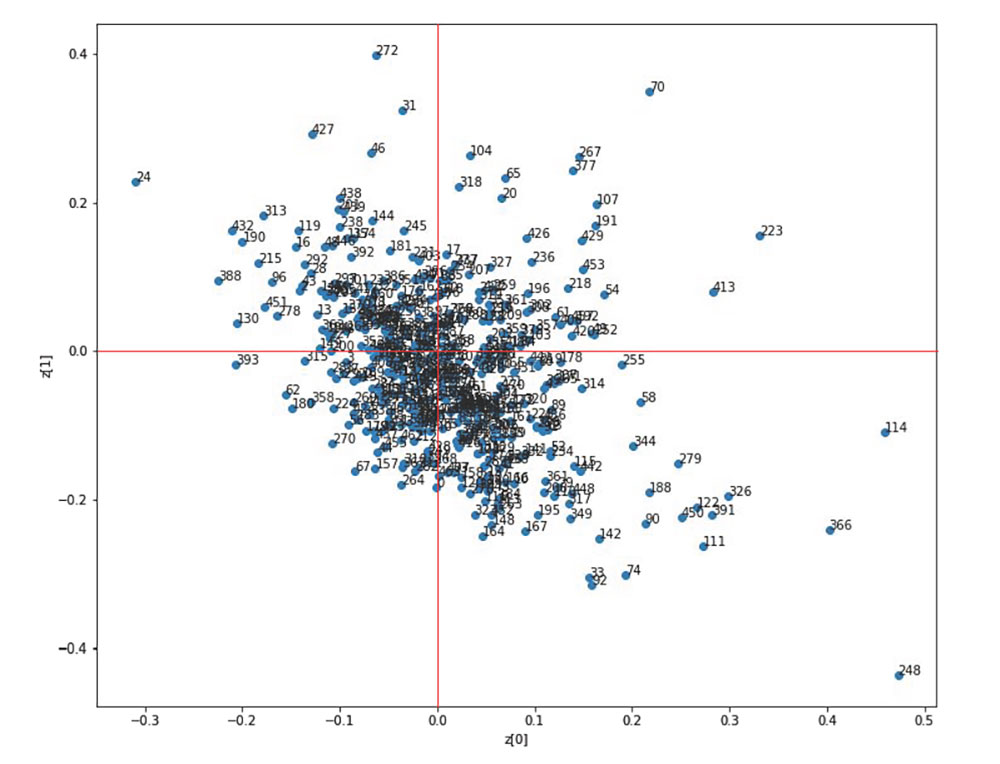
The Seiko Mikami Archive is one of the material collections housed in Tama Art University Art Archives Center (hereafter AAC) which was established in 2018. MIKAMI Seiko was appointed as a faculty member of the Department of Information Design at Tama Art University in 2000, while working as an artist since the 1980s. She was involved in production and education centered on media art until her death on January 2, 2015. AAC compiled the archives from materials related to MIKAMI’s activities with the cooperation of the Yamaguchi Center for Arts and Media [YCAM] (hereafter YCAM), which has collaborated on MIKAMI’s large-scale interactive media installation works since its establishment in 2003, and of her bereaved family.1
The materials in the AAC’s collection range from those related to MIKAMI’s artwork production and exhibitions to those related to university education and paperwork, as well as those related to her daily life. As they are a wide variety of materials, it cannot be said that they are well organized yet as archives. However, through several ongoing projects, we are gradually surveying and understanding the materials’ content. For example, in academic year 2020 and ’21, as part of a survey of the current state of recording media, mainly video, a simple list was compiled of the quantity of items in the collection and information known from their external appearance. In addition, some recording media were viewed with the cooperation of Tama Art University Media Center, and the video content was also written in the list.2 We also collected information on MIKAMI’s activities as an artist since the 1980s (exhibitions, events, talks, juries, etc.) and as a faculty member after her arrival at Tama Art University (lectures, seminars, on-campus events, positions, etc.). We created a chronological table that lists these activities. Information (in websites, books, reviews, etc.) on activities was also researched, and a list of websites, databases, and archives used for the research was created.
KUBOTA contributed to the anthology about MIKAMI Seiko, SEIKO MIKAMI: A Critical Reader (NTT Publishing), edited by MA Jung-Yeon and WATANABE Tomoya and published in March 2019. In his text “Tama Bijutsu Daigaku ni okeru media art kyoiku no jissen” (The practice of media art education at Tama Art University), KUBOTA outlined MIKAMI’s thoughts and practices as an educator over the past 15 years by looking back on the process of her education. He also introduced “Media art genron” (Principles of media art) an open course that MIKAMI offered to students throughout the university. We attempt to organize and reorganize materials related to the course, and to update them as lecture materials that can be used continuously in art education.3 MIKAMI’s lecture, “Media art genron”, is characterized by its attempt to introduce (new) media art, which emerged mainly in Japan and Europe in the 1990s, covering not only the trends after its emergence, but also its historical background and social trends, including art movements and related fields that preceded it, from multiple perspectives and across disciplines, while also discussing the latest topics. The archives contained the slides and other materials that MIKAMI had used in her lectures. Therefore, ISHIYAMA, who had attended the lectures while she was a student in the Department of Information Design at Tama Art University, and KUBOTA decided to organize and analyze the content of the lecture slides and reorganize them so that they can be used in art education today beyond the constraints of time and place, especially for online learning, which has become indispensable due to the COVID-19 pandemic (Fig. 1). The content is updated every year, while the overall structure of the lectures, covered content, and MIKAMI’s original texts are maintained as the framework of the lectures. The “present” of the time when the lectures were held is embedded in the materials. We aim to make them function continuously by collecting, and reflecting as needed, relevant trends, materials released by domestic and international archives, and information useful for learning about the artist and her works since academic year 2014, the last year the lectures were held. As for a prototype, KUBOTA actually used the materials in a class at Tama Art University, and set up a system that allowed viewers to post their opinions, and he improved the lecture materials based on the feedback obtained through the system. In addition, in collecting information from academic year 2014 onward, we have attempted to share information received from viewers by providing a form to solicit information from them. We will continue to review and update the lecture materials. In the lectures, MIKAMI also introduced her own works. In other words, this procedure is also connected to the exploration of the background of MIKAMI’s work production.
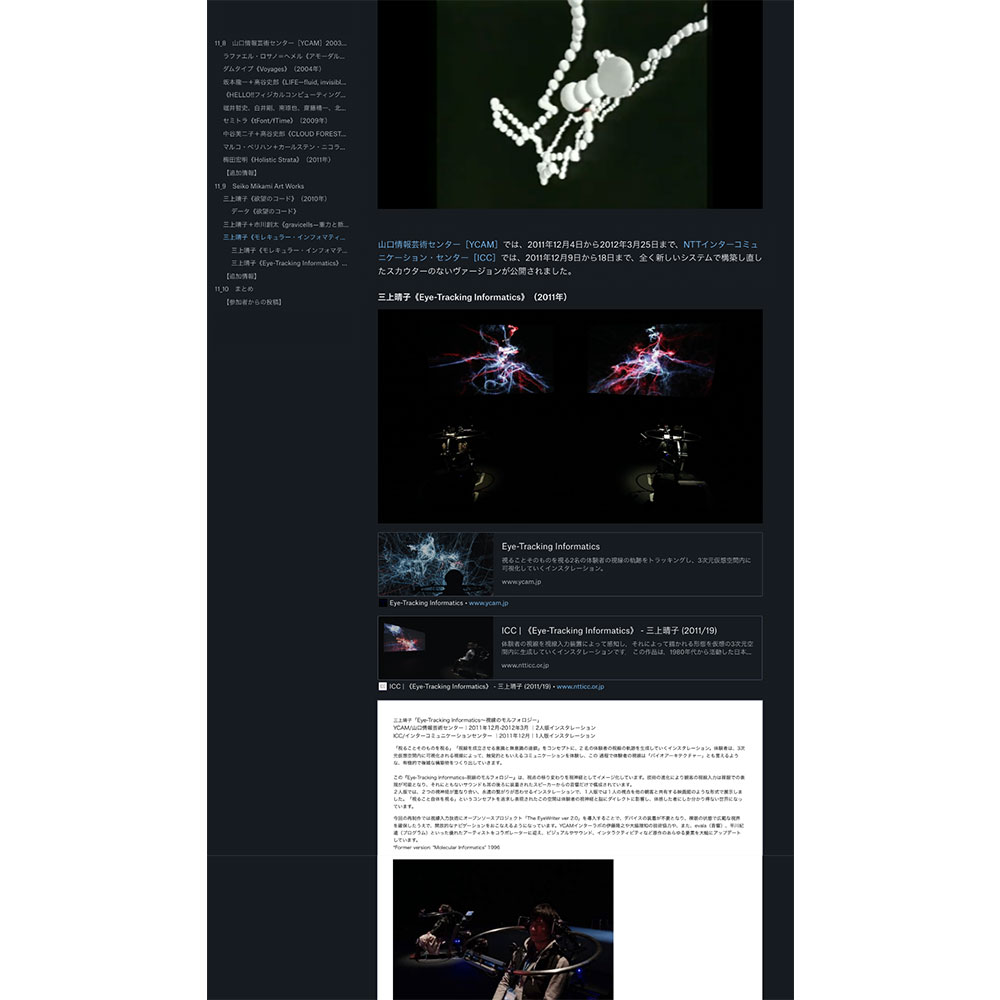
One of the characteristics of the interactive media installations that MIKAMI has created and explored is that they would not be completed without the viewers who experience them. In order to explore the nature of such interactive art, we have been conducting research on interaction archives, using Eye-Tracking Informatics (hereafter ETI), created by MIKAMI in 2011 and recreated by YCAM in 2018, as a case study. ETI is an interactive artwork based on the concept “observing the act of observation.” A device detects the viewer’s gaze. From the gaze’s movement, a three-dimensional virtual structure is generated in an algorithmic manner. The dynamically structured gaze is then observed at again by the viewer, creating a feedback loop of “observing the act of observation.” When two people experience the work simultaneously, communication between these two people through their gazes becomes possible (Fig. 2).
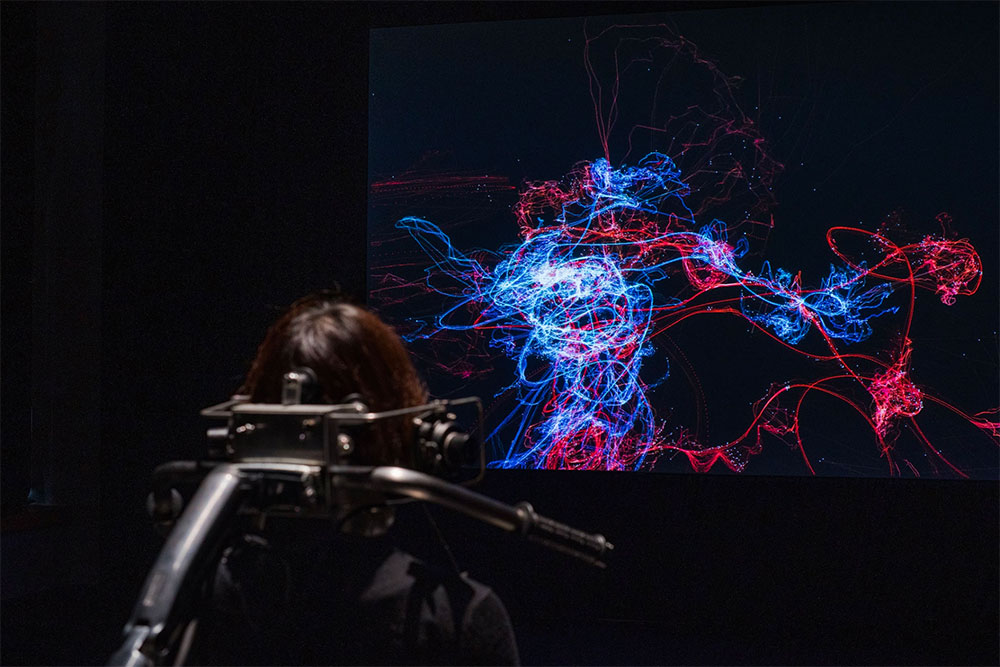
The recreated ETI was demonstrated at the “MIKAMI Seiko Eye-Tracking Informatics Version 1.1 – Exhibition of joint research results in collaboration with YCAM” held from January 9 to 11, 2019, at Art-Theque Gallery 105 in the AAC.4 This was followed by a long-running exhibition held under the “Open Space 2019: Alternative Views” exhibition at the NTT InterCommunication Center [ICC] in Hatsudai, Tokyo, from May 18, 2019, to February 28, 2020. In order to explore the interaction itself between eye movement and structure in ETI, the position of the viewer’s gaze during the experience and the generated virtual structure were recorded from January 12, 2020 until the end of the exhibition, with the cooperation of HIRAKAWA Norimichi, who was in charge of the visual programming of the work, and with the consent of the people who experienced it. For each five-minute experience, approximately 15,000 samples were acquired, in which the time stamp of each display frame, the movement of the viewer’s gaze on the screen, and the three-dimensional coordinates of the framework of the generated virtual structure were recorded.
First, we visualized and quantitatively analyzed each of the 770 recorded data examples.5 By comparing eye movements and shapes of the structures generated from them, and data of the speed and acceleration, it has become clear that there are several modes of interaction in ETI.
Among them are two representative modes: “gliding mode,” in which the gaze does not move much and a smooth structure is generated, and “turning mode,” in which the gaze moves frequently and takes on a curled structure. This mode can be further divided into a “pursuit mode,” in which the gaze strolls through the virtual space, and a “chase (escape) mode,” in which the gaze chases or escapes the generated structure (Fig. 3).

In academic year 2021, with the help of DOZONO Shoya, we worked to gain an overall picture of the acquired interaction data by analyzing all eye gaze data from ETI using machine learning, based on this analysis of individual data. The gazes and the shapes of the virtual structures were classified using a Variational Auto Encoder (hereafter VAE), an unsupervised learning method for acquiring data features, to classify all the data and extract its typical and special cases (Fig. 4). The overall picture of interactions in ETI gradually emerged through this analysis.
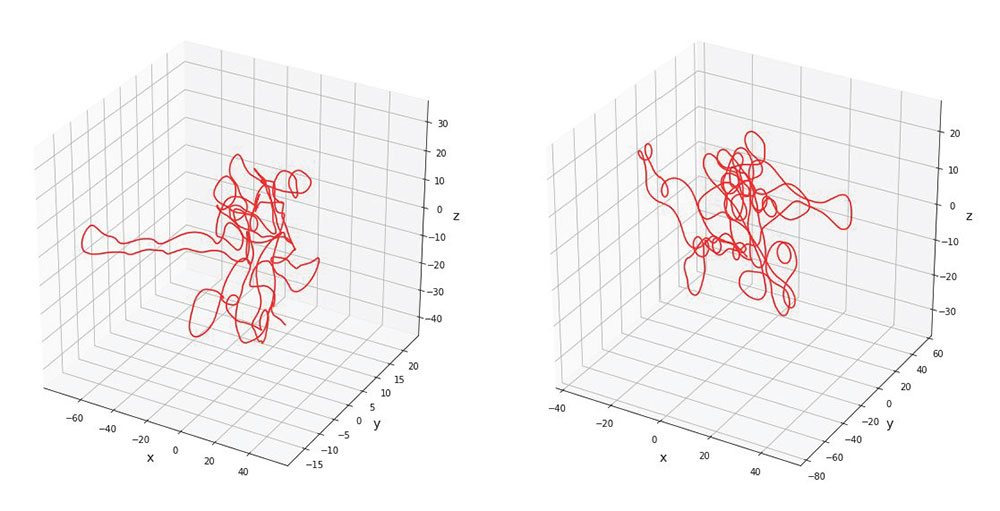
In parallel, we are constructing an experimental environment called “Proto-ETI” to verify the interaction analysis of ETI with the cooperation of HIRAKAWA Norimichi. “Proto-ETI” is a structural simulator for ETI that generates only the skeleton of the virtual structure of ETI from gaze-detection devices, mouse input, and these recorded data. In addition, the interaction parameters of the ETI can be set and changed in real time via the UI, and the user can choose whether to communicate with another viewer and whether to draw a grid on the screen, which will make parametric experiments in interaction possible (Fig. 5).
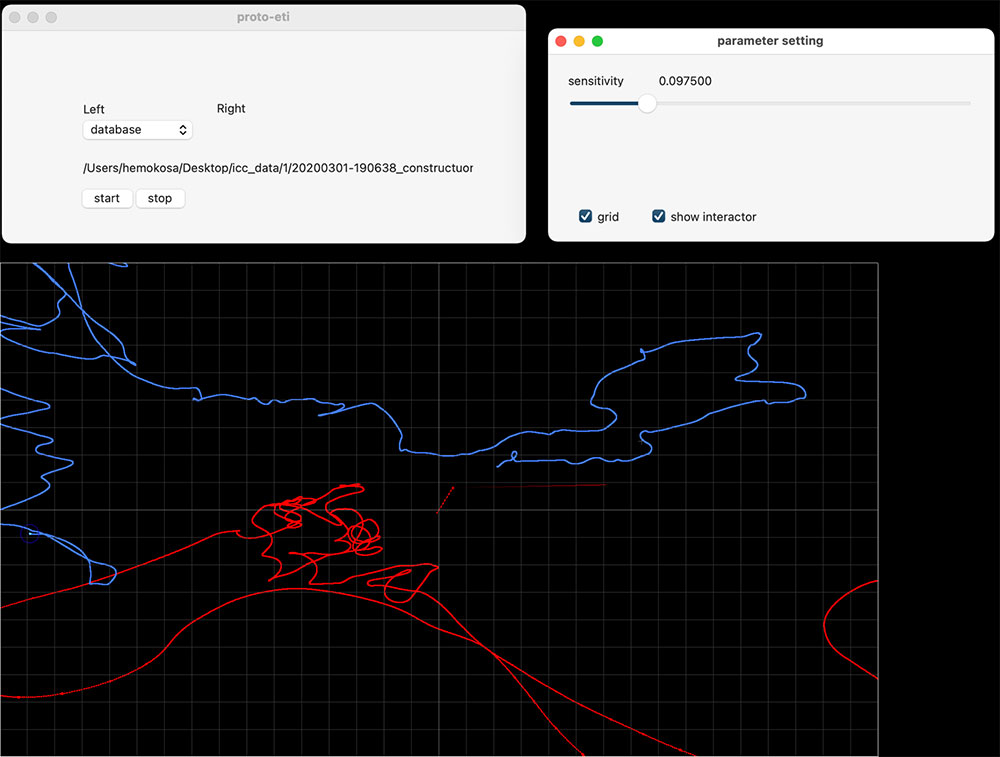
In addition, the “Proto-ETI” allowed creation of a new viewing experience or appreciation of a virtual structure generated by interaction over and over again (Fig. 6). In the exhibition of conventional ETI, it was necessary to change viewers one after another, and they were not possible to observe the created virtual structure leisurely pace after the experience was over. We would like to consider the possibility of “viewing the interaction” made possible by “Proto-ETI” in the future. Furthermore, the aforementioned VAE can generate not only structures but also eye movements themselves from the learning data, making it possible to reanalyze and appreciate the structures resulting from the virtual experience using such generated eye movement data. We will continue to combine machine learning and “Proto-ETI” to examine the meaning of understanding, interpreting, and appreciating interactive artworks, of which ETI is a typical example.6
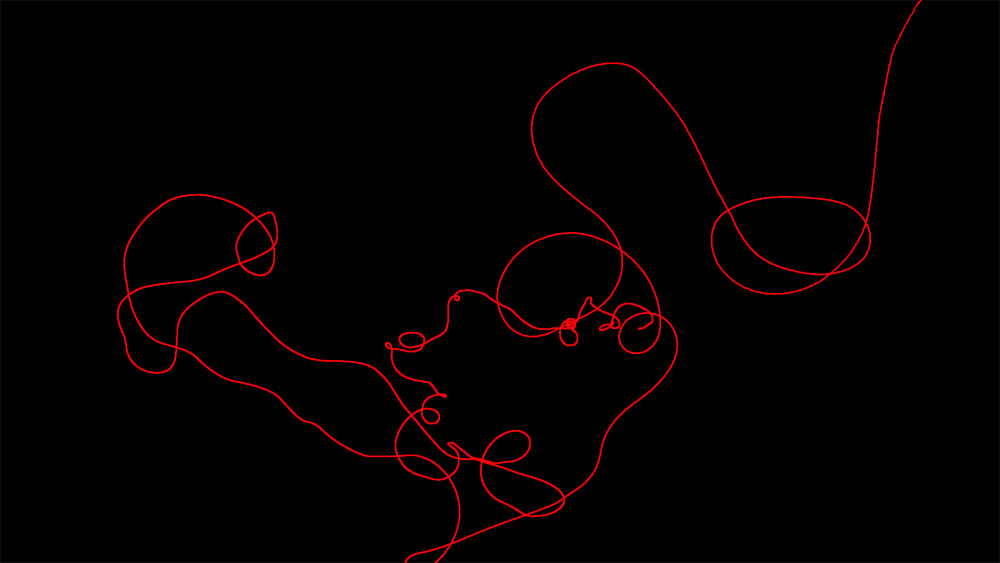
As mentioned above, the Seiko Mikami Archive is still in the process of being developed as an archive, but we are in the process of putting in place a system that will make it possible to respond to individual requests for access to the materials in the collection. At the same time, related research results are published from time to time at the Art Archives Symposium held every year in early December, the Art Archival Journal KISEKI published by the AAC, Tama Art University bulletin, and other publications. In the future, we would like to consider making the materials available to the public via the Internet.
Based on “Media art genron” and the results of the interaction analysis of ETI, we have started designing and trial implementation of the “Platform for Media Art Production (PMA),” a platform that helps “communicate,” “learn,” and “create” media art. Currently we are working on this platform with HORIGUCHI Junshi and others in the “Survey of Media Art Works and Development of Data for Media Arts Database,” a project conducted under the Project to Improve Networking and Archival Infrastructure of Media Arts.
notes
*Part of this research was supported by JSPS Grant-in-Aid for Scientific Research JP21K00117
*URL link was confirmed on February 20, 2023.